The Men Who Marched Away
The Men and Women of the Leven Valley Who Served in World War One- Includes Renton's Roll of Honour
Introduction Page 3
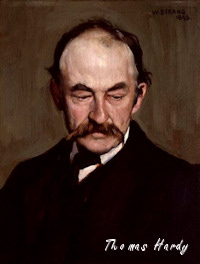 Thomas Hardy, perhaps the best-known novelist in Britain at the outbreak of WW1, and by then a 74 year old man, was so moved by the immediate response of the young men of Britain to the call to the colours, that within a month of the outbreak of the war he laid aside his novels and in September 1914 penned the poem “Men Who March Away”. It is a tribute to the young men whom Hardy had seen marching away from the villages around his Dorset home and it was immediately recognised as capturing the spirit of the time with its references to
Thomas Hardy, perhaps the best-known novelist in Britain at the outbreak of WW1, and by then a 74 year old man, was so moved by the immediate response of the young men of Britain to the call to the colours, that within a month of the outbreak of the war he laid aside his novels and in September 1914 penned the poem “Men Who March Away”. It is a tribute to the young men whom Hardy had seen marching away from the villages around his Dorset home and it was immediately recognised as capturing the spirit of the time with its references to
“...the faith and fire within us” and
“In our heart of hearts believing
Victory crowns the just,
And that braggarts must
Surely bite the dust”
However, like many of the older generation at the time, Hardy’s respect for the young men was tempered
“With doubt and dolorous sigh”.
He was hugely impressed by the rush to join the colours, but he couldn’t escape the foreboding that was felt by many, especially wives and mothers. Almost a lone literary voice in September 1914 in expressing doubts and sighs, he was to be proved only too perceptive in his concerns for the lives of the young men – and women - who marched away all over Britain. The women mainly served in nursing units but as the war went on and casualties increased many of these medical units in which female nurses served, moved perilously close to the front and many nurses were killed or died of other injuries and illness while serving in the forward areas.
So the title and subject of his poem seems to be the most appropriate one on which to base the title of the articles which will describe the young men and women of this area who marched away to war, initially with no foreknowledge of what awaited them. Later perhaps with fear and apprehension, but still with an overwhelming sense of going to do their duty and not letting anyone down.
 Almost 100 years later, it is impossible not to be similarly affected by the sacrifices made by these young men – and women – right from the outbreak of war on 4th August 1914. In the first month of the war 500,000 men in the UK volunteered to serve in the Army, swamping its ability to absorb, train and equip them. It is conventional to see this as a naive, jingoistic rush to the colours by young people who thought the war would be over by Christmas, and they wanted a bit of adventure in these few months between August and December.
Almost 100 years later, it is impossible not to be similarly affected by the sacrifices made by these young men – and women – right from the outbreak of war on 4th August 1914. In the first month of the war 500,000 men in the UK volunteered to serve in the Army, swamping its ability to absorb, train and equip them. It is conventional to see this as a naive, jingoistic rush to the colours by young people who thought the war would be over by Christmas, and they wanted a bit of adventure in these few months between August and December.
Of course, it wasn’t as simple as that. There were some who really did believe that the war would be finished by Christmas, and most people certainly hoped it would be. But most were more realistic than that. Many joined because they wanted to defend small Belgium against the serial-aggressor Germany. Some joined because they didn’t have a job, others because they didn’t like the job they were in. Most did so out of a sense of patriotism and adventure, with peer-pressure a deciding factor.
Bernard Bergonzi probably got it right for one section of society when he wrote of the Oxford and Cambridge University men “...innumerable young men responded to the war with feelings that were a compound of traditional patriotism and boredom with the world they had grown up with”. Boredom is an interesting word, since it was barely 60 years old in English usage when WW1 broke out, and it was an extravagance that probably didn’t extend too far in the Vale; where most people did not have the luxury of being bored. Patriotism, on the other hand, was a very strong motivating force across the whole community.
Most of the photos you see of the time show the scenes at recruitment offices in London, but in fact the highest percentages of recruitment per head of population were in the urban areas of the northern part of Britain, which also happened to suffer from the highest unemployment. Not surprisingly, Scotland led the way.
Recruitment in Dumbartonshire
Both in terms of the percentage of the population who served in the Army and in percentage of deaths on active service, Scotland considerably out-performed the rest of the UK and indeed was one of the leading countries in both categories in either side. The men of the county of Dumbartonshire also volunteered in impressive numbers. By November 1915 it was reported that 40% of all eligible men had already enlisted, while a further 35% had been identified as working in reserved occupations, which meant that as early as December 1915 there was only 25% of the eligible male population of the county available to be conscripted.
Recruitment in this area
The Vale as a whole was typical of these figures. There had been a strong tradition, based around the various printing and dyeing Works in each village, of serving in the Volunteers and then the Territorial Army when it was created. With the exception of Balloch, every village in the Vale had a Drill Hall and a Territorial Unit which was part of the 9th Battalion of the Argyll & Sutherland Highlanders.
In the years leading up to the outbreak of war, many Vale men had signed on from these part-time units into the Regular Army, which was small and made up entirely of volunteers, unlike its counterparts on the continent, especially Germany and France.
When they joined up in 1914-15 they did not necessarily go into the ASH, but were sent to whichever regiment was in most need of new recruits. This usually turned out to be Highland Regiments such as the Cameron Highlanders, Seaforths and Gordons whose core recruitment areas were in more sparsely populated parts of Scotland and needed top ups in wartime from the central belt of Scotland. Some Valemen also found themselves serving in Irish and English regiments, while many others went to the Artillery Regiments, Service Corps, the Royal Navy and the Royal Flying Corps.
At the war’s outbreak, a recruitment campaign was implemented by the government which included one of the most enduring advertising images of all time, Kitchener’s face and finger pointing from a poster saying “You’re Country Wants You”. As early as 12th September 1914 the Lennox Herald was reporting a packed and enthusiastic recruitment meeting held in the Public Hall and addressed by such luminaries as Mr Acland Allen the local MP, his predecessor Mr Alex Wylie and Colonel Henry Brock after whom the first hospital in the Vale was called.
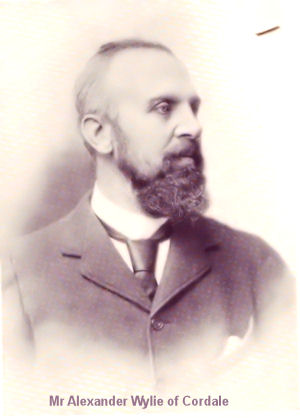 The government’s efforts were supported by many other initiatives, both national and local. In Dumbartonshire a Dumbartonshire Recruiting Committee was formed and its chairman throughout the war was local man Mr Alexander Wylie of Cordale, who had been not only a principal shareholder in William Stirling & Co, owners of Cordale and Dalquhurn Works, and after its creation in 1897 of the United Turkey Red Company, but also the Tory MP for the County of Dumbartonshire from 1895 to 1906, when he retired from Parliament.
The government’s efforts were supported by many other initiatives, both national and local. In Dumbartonshire a Dumbartonshire Recruiting Committee was formed and its chairman throughout the war was local man Mr Alexander Wylie of Cordale, who had been not only a principal shareholder in William Stirling & Co, owners of Cordale and Dalquhurn Works, and after its creation in 1897 of the United Turkey Red Company, but also the Tory MP for the County of Dumbartonshire from 1895 to 1906, when he retired from Parliament.
Wylie remained prominent throughout the war in all the various local organisations which supported soldiers and the war effort in general, and he appears at many local functions honouring not only Vale and Renton men, but also women, who were serving with the colours. Also worth mentioning is one of Dumbarton Burgh & County Tramways trams which was decked out in flags, patriotic slogans and posters and toured the tramlines as a sort of mobile recruitment office, inviting young men to ‘join up to-day’ throughout the western part of the county.
By this time of course all of the Regulars and Reservists of the British Expeditionary Force (BEF), which sailed to France, had already been engaged in heavy fighting for a couple of weeks. There were many Vale men in the BEF serving in a variety of units, as we well know from the early casualty reports. The contribution of the men of Bonhill, Luss and Kilmaronock Parishes was in line with the very high standard set by the rest of Scotland, but that of Renton was truly exceptional.
Renton’s Roll of Honour
All of the stories about Renton and WW1 which have been carried down the years as part of this area’s oral history seem like urban myths, perhaps just old soldier’s tales. In fact, they have a substantial core of truth and for every story which is perhaps a bit overdone, there is another fact which makes you shake your head – sober, frequently sad, but always impressive. In describing those in the Vale who joined the colours in WW1, Renton deserves pride of place.
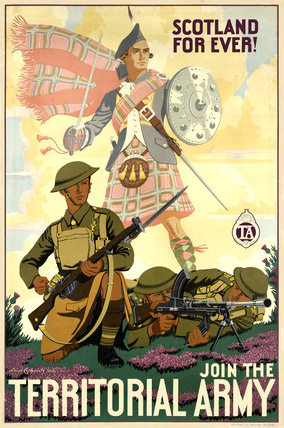 Already by September 5th 1914, just over a month since the war had started, Lennox Herald was reporting that Renton had sent between 250 and 300 men to serve in the Regulars and Territorials, while in the next week’s edition of the Lennox, 12th September, it was announced that so many juvenile footballers in the village had volunteered that the Renton juvenile football competition had been disbanded.
Already by September 5th 1914, just over a month since the war had started, Lennox Herald was reporting that Renton had sent between 250 and 300 men to serve in the Regulars and Territorials, while in the next week’s edition of the Lennox, 12th September, it was announced that so many juvenile footballers in the village had volunteered that the Renton juvenile football competition had been disbanded.
It was an initiative, however, by a national newspaper which provides us with the best information about Renton’s immediate response to the outbreak of war. The Weekly Despatch newspaper was at the time the largest selling Sunday newspaper in the UK. Older readers will remember it as the Sunday Despatch to which it changed its name in 1928. It ceased publication in 1961.
In 1914 it was owned by Alfred Harmsworth and Lord Rothermere, whose family are still involved with Associated Newspapers, owners of the Daily Mail amongst many other things. They were ardent supporters of the war, and always on the lookout for ways to help the war effort. One of the things the Weekly Despatch came up with was a “Bravest in Britain” campaign to identify the town / village in Britain in which most people had volunteered for service, as a percentage of the total population of the town / village.
This equation of volunteering with bravery was universally accepted at the time and probably still would be in the most part to-day. There was a huge response to this campaign across the UK and the people of Renton rightly believed that their efforts at least matched the best, and they started to draw up a Roll of Honour containing information about all of the Renton men who had volunteered for the colours from the outbreak of the war.
The Details of Renton’s Roll of Honour
By March 1915, in other words, just over five and a half months from the start of the war, it was ready. It was drawn up by a single individual, Sergeant Marr, who did a very thorough job which tells us a great deal about the surge to the colours by Renton folk – remember this was long before conscription was introduced. Unfortunately, although the Roll of Honour listed all the names, addresses and units of all of the volunteers, that part of the information seems to have been lost – at least we haven’t found it so far. So we don’t know who all of the volunteers were in 1915 – except for those in casualty reports or with an exceptional story to tell who made it into the local papers.
However, what has survived is impressive enough to be getting on with. By March 1915, 496 Rentonians out of a total population of 4,977 had joined the colours – a simple 10% of the total population. Narrowing the percentage down to adult males between the ages of 18 and 70, of whom there were 1,571, that percentage increases to 31%, while on the most important measure of all, that of the eligible age for joining the forces which was between 18 and 50 years old, the percentage shoots up to 58%. So as early as March 1915, 58% of Renton’s young men were already with the colours. It must have been a pretty eerie place with few young men in churches, factories, pubs, football teams etc.
Practically every family had someone serving. In three families no less than 5 men each had joined up:
- The O’Neills
- The Flemings
- The Kennys
Many other families had 4, 3 or 2 sons serving with the colours.
Although the largest single number had gone to the local regiment, the Argyll & Sutherland Highlanders, the majority had gone to other units, literally across the globe. The main regiments / units joined were as follows:
- 175 Argyll & Sutherland Highlanders
- 6 Black Watch
- 14 Gordon Highlanders
- 16 Cameron Highlanders
- 2 Royal Scots
- 14 Seaforth Highlanders
- 15 Highland Light Infantry
- 15 Scottish Rifles
- 11 Scots Guards
- 4 Scots Greys
- 27 Royal Scottish Fusiliers
- 6 Royal Dublin Fusiliers
- 41 Royal Field Artillery
- 18 Royal Garrison Artillery
- 19 Royal Engineers
- 13 Army Service Corps
- 1 Calcutta Light Horse. Perhaps some reader knows who this is; he certainly deserves a mention for serving in the most unlikely, not to say most exotic, unit
- 9 Royal Navy
- 7 Canadian units
There were 60 or so others serving in ones and twos in many Irish, Scottish and English regiments as well as Empire forces from Australia, West Africa etc. Remember all of these men were volunteers - either Regulars, Territorials or volunteers from the early months of the war. After War broke out most would probably have expected to have volunteered for the Argylls, but already other units across the army had greater need of them than the Argylls which already had all the new recruits that it could handle, and Renton men were spread far and wide. As the casualties mounted up from mid 1915 onwards this turned out to be no bad thing, although truth to tell every field unit of the army – infantry, artillery and the various supporting Corps such as Royal Engineers and Royal Army Service Corps took appalling losses throughout the war, and there were no safe billets.
It is to be hoped that the 9 men who were serving in the Royal Navy had actually volunteered to be sailors. At that stage of the war, they probably had. But the Navy too lost a lot of men.
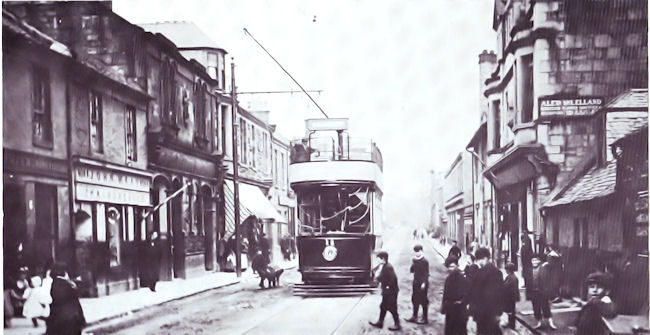
Main Street Renton
We also know in which streets these men lived, and the breakdown of that is as follows:
- 155 Main Street
- 112 Back Street
- 38 Lennox Street
- 10 John Street
- 7 Alexander Street
- 7 Leven Street
- 10 Hall Street
- 21 Carman Road
- 10 Station Street
- 33 Burn Street
- 21 Thimble Street
- 17 Waterside Place
- 28 Stirling Street
- 14 King Street
- 5 Red Row
- 9 Dalquhurn
Main Street provided half as many soldiers again as Back Street in the first months of the war. However, that raw fact tells less than the whole story, because then as now Back Street was less than half the length of Main Street, and therefore had less population than Main Street. The Valuation Rolls for May 1914 show that Main Street had about 384 inhabitable houses in the summer of 1914 while Back Street had only 216. On a percentage basis, therefore, each house on Back Street produced 0.5 of a soldier, while Main Street was slightly less on 0.4, so Back Street is ahead on a “per house” basis. However, the contributions of both Streets are very impressive by any standards, especially when the households where the inhabitants were too old, infirm or widowed with a young family are factored out.
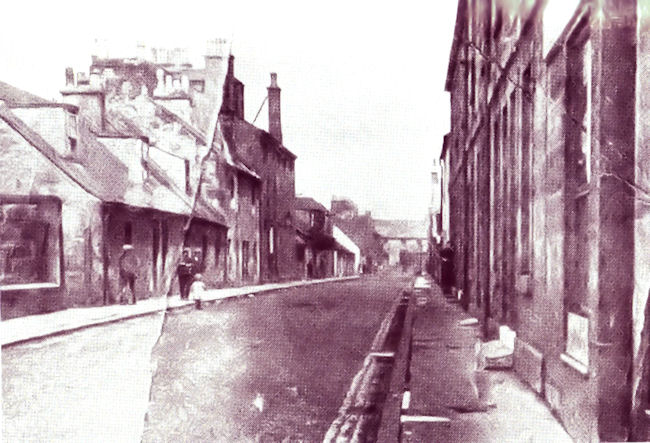
Back Street Renton from Willie Murphy’s Book “Renton Between the Wars”
So, all the stories about every house in Back Street that could send a soldier to war actually doing so are as near true as makes no difference, and Main Street is not far behind. And remember, this was just March 1915, with another three and a half years of heavy fighting ahead years in which many, many more Rentonians joined the forces.
This figure of 496 would be impressive enough for the duration, and although we don’t know what the accurate final figure is for the number of Rentonians who served in WW1 it would be well over 700, probably nearer 800. Of them, 157 were killed and their names are to be found on the Renton War Memorial.
Although, as has been said, we don’t have a complete list of the names of Renton folk who served in WW1, either from the above-mentioned 1915 Roll of Honour nor any other, one Renton institution did draw up a Roll of Honour of its own members which has survived – Lodge Leven St John No170. This Roll of Honour hangs in the entrance hall to the Lodge, and what an impressive yet simple document it is. Written and painted on paper it consists of 3 columns of members’ names, the unit in which they served and it notes those who were killed. The list is surrounded by a painted border which depicts the flags of the allied nations, a scene from the front line, complete with barbed wire and a couple of Masonic references. The flag of Serbia went on to become the flag of the then newly-created Yugoslavia and since 1992 it has reverted to being the flag of Serbia and Montenegro. The flag of the Russian Empire wasn’t quite so lucky. It disappeared by the early 1920’s when the Soviet Union was created and has not re-appeared. Coincidentally with the Lodge number, there are 170 members on the list, which must have been a very sizable proportion of the membership at the time of those who were eligible to serve.
Bonhill Parish – No Roll of Honour
While the men in the rest of this area volunteered in broadly similar numbers to Renton, the efforts to prepare a Roll of Honour for Bonhill Parish were pathetic. Renton acted, the rest of the Vale talked, is about the nicest way to put it – nothing new there then, Renton people will be saying. As a result, we have no information source about Bonhill Parish which begins to compare with the March 1915 Renton Roll of Honour and have to rely on reports in the Dumbarton and Lennox Heralds, the casualty lists and the few surviving Rolls of Honour drawn up local organisations to have an idea of the scale of the Parish’s presence in the armed forces.
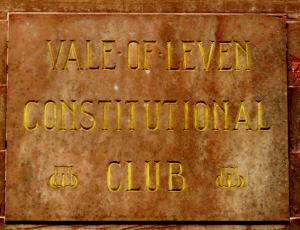 This need not have been so, because Bonhill Parish had one apparent advantage which Renton did not have at that time – a local Parish Council, Bonhill Parish Council, then head-quartered in the Constitutional Club Rooms in Bank Street, which are still standing.
This need not have been so, because Bonhill Parish had one apparent advantage which Renton did not have at that time – a local Parish Council, Bonhill Parish Council, then head-quartered in the Constitutional Club Rooms in Bank Street, which are still standing.
Soon after the war broke out and the scale of volunteering had become apparent, Councillor John Barton (after whom Barton Avenue in the Haldane is named) proposed that a Roll of Honour be drawn up. There was already a good written basis for this because there was a local branch of the Soldiers & Sailors Families Association, and its membership list was obtained.
It was further proposed that each councillor would collect all additional names of everyone who had volunteered in the ward which they represented and add them to this list, thereby making up a Parish Roll of Honour. Since the wards were quite small and there were at least two Parish Councillors for every ward, this was not regarded as a very onerous task, and the councillors unanimously agreed to the suggestion. The next that is heard of this sensible and honourable suggestion is when it had to be reported at a Council meeting in October 1916 that in the intervening two years only a few councillors had done anything about implementing this suggestion and no Roll of Honour existed.
If you thought that this sorry admission might have sparked off apologies and breast baring all round, you have clearly underestimated the councillors’ collective capacity for evasion and mendacity. What happened is that the councillors who contributed to the meeting – most stayed silent on this subject – squabbled amongst themselves, not about why they had done nothing, but about what they would have done, if only they had done anything at all and who would have been on the Roll if it had been drawn up.
Councillor Barton, for instance, said he had only intended that volunteers be included, not conscripted men. He knew as well as anyone that when he made his proposal and for the following 17 months of the war there only were volunteers, therefore what he was saying was utterly pointless. In time-honoured political tradition the whole issue was kicked into the long grass by agreeing to set up a committee to prepare a Roll which would include every serving man, whether a volunteer or a conscript. The meeting quickly passed on to discussing complaints about queues outside picture houses blocking pavements on a Saturday night – now that was something they could clearly pontificate on for hours on end, and required no effort on their part. Nothing had been done and nothing was to be done; and that was the last that was heard about a Bonhill Parish Roll of Honour.
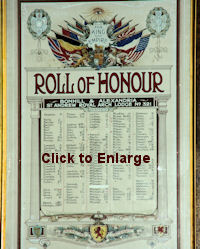 Other Rolls of Honour
Other Rolls of Honour
However, a number of other Rolls of Honour were drawn up in the Parish and two at least have survived – one in Bonhill Primary School containing a list of all former pupils who served in the War, and another in the Masonic Temple in Alexandria which has a list of its members who served.
The Lennox Herald Roll of Honour
However, right from August 1914 the Dumbarton and Lennox Heralds tell of many Valemen who served. The first major source was a Roll of Honour of Men who volunteered at the County recruitment headquarters in Dumbarton which first appeared in the Lennox Herald of Saturday September 12th 1914.
The great majority of the names are from Dumbarton since most Vale recruits volunteered at the local drill halls, but the following men are from the Vale. (General Service means that the Army will allocate the man to a regiment of greatest need rather than allowing him to choose.)
Up until Thursday 20th August 1914
| Thomas McCann | Alexandria | General Service |
| Edward Docherty | Alexandria | Seaforth Highlanders |
| John Robb | Alexandria | General Service |
| John Burns | Alexandria | General Service |
| Thomas Goldie | Alexandria | General Service |
| Norman Paterson | Alexandria | General Service |
| Patrick Coyle | Alexandria | General Service |
| Alex Ferguson | Alexandria | General Service |
| George Cameron | Alexandria | General Service |
| John Denny | Alexandria | General Service |
| Francis Martin | Alexandria | General Service |
| Daniel Carr | Alexandria | General Service |
| John Connolly | Alexandria | General Service |
| William Eldridge | Alexandria | General Service |
| James Docherty | Alexandria | General Service |
| Patrick Murphy | Alexandria | General Service |
| John Gillespie | Alexandria | General Service |
| Wm Devenay | Alexandria | General Service |
| John Stevenson | Alexandria | General Service |
| John Docherty | Alexandria | General Service |
| Michael McIlrun | Alexandria | General Service |
| Joseph Denny | Alexandria | General Service |
| Archibald Pollock | Alexandria | General Service |
Friday 21st August 1914
| Robert Black | Alexandria | General Service |
| Alex McColl | Alexandria | General Service |
| John Moore | Alexandria | ASH (Argyll & Sutherland Highlanders) |
Monday 24th August 1914
| James Wright | Alexandria | RFA (Royal Field Artillery) |
| Bernard Sweeney | Alexandria | RFA |
| John Ross | Alexandria | RFA |
| James Keenan | Alexandria | RFA |
| Michael Gleancy | Alexandria | RGA (Royal Garrison Artillery) |
Thursday 27th August 1914
| William Stewart | Alexandria | Seaforth Highlanders |
| James Gray | Alexandria | ASH |
| Andrew Kelly | Alexandria | ASH |
| John McKenzie | Alexandria | ASH |
| Alexander McMurray | Alexandria | RSF (Royal Scots Fusiliers) |
| Walter McAdam | Alexandria | RSF |
| Charles McEwan | Alexandria | RSF |
| William Miller | Alexandria | 2nd Dragoons the Royal Scots Greys |
| James Goudie | Bonhill | RE (Royal Engineers) |
| Benjamin Haslewood | Alexandria | 2nd Dragoons the Royal Scots Greys |
| Alex Finlayson | Alexandria | 2nd Dragoons the Royal Scots Greys |
| John Davin | Alexandria | ASH |
| Richard Forsyth | Alexandria | ASH |
| Charles Docherty | Alexandria | ASH |
Families with many members serving.
Families were of course large in those days so its not surprising that many families contributed 4 or more sons and even grandsons to the forces. We have already seen some large Renton families, but there were a number of others in different parts of the Vale.
From the outset Mr & Mrs John Stevenson of Susannah Street Alexandria had 5 sons signed up with the colours. The eldest was serving with the Argylls, Robert was in the Highland Light Infantry, Donald was in the Kings Own Scottish Borderers, Tom was in the Black Watch and Frank was a Reservist awaiting a call to his regiment. Tom and Donald were to die in the war.
By June 1915 Mr & Mrs Archibald McGlashan of Main Street Bonhill had not only 5 sons serving, but also a grandson. One of their sons had already been wounded and invalided home.
The McRaes, John and Margaret, of 27 Albert Street Alexandria were the most tragic Vale parents of the war. They also sent 5 sons off to the war. One son, James McRae, was killed in August 1917. In January 1918 they learned that a second son, John, had been killed in November 1917. But much worse was to come, because by the time the war ended on November 11 1918, two further sons had been killed, William being killed in August 1918, The body of the last to die, Gunner George McRae of the Royal Field Artillery, who died on 13th November from wounds received in the fighting, was brought home to be buried on 17th November 1918, six days after the end of the war, in Bonhill Churchyard. As can be imagined, there was a very large attendance at the military funeral and many people who attended it had themselves lost 1 or 2 members of their own family, but thankfully no other family in the Vale had lost 4 sons.
Next: The Casualties of War >


